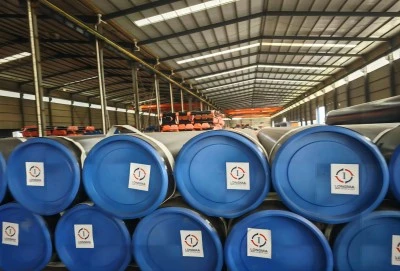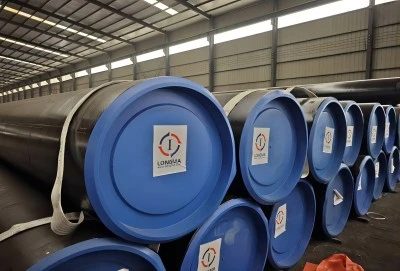There are several types and manufacturing methods for steel pipes on the open market. In the industrial and construction domains, rolled and welded steel pipe is one such variety that has become incredibly popular. But have you ever wondered why it's called that? We will dive into the fascinating world of rolled and bonded steel pipes in this post, studying their production method, how they differ from other steel pipes, and how they have evolved.
|
|
|
The Production Process: Rolling and Welding Explained
The term "rolled and welded steel pipe" describes a manufacturing process that is both efficient and cost-effective, and it involves two primary stages: rolling and welding. This method of producing steel pipes is widely favored across various industries due to its reliability and affordability.
The production process begins with a flat steel plate or coil, selected based on the desired specifications for the final product. This initial steel sheet undergoes a series of steps to transform it into a pipe. First, the flat steel is fed into a set of rollers. These rollers are designed to gradually bend and shape the steel into a cylindrical form. As the steel progresses through the rolling mill, it is continuously curved until it assumes the shape of a complete tube. This shaping process is meticulously controlled to ensure that the pipe maintains uniform dimensions and quality.
After the steel has been rolled into its tubular shape, the next step is to join the edges of the steel tube through welding. This welding process is essential to ensuring that the pipe is structurally sound and capable of withstanding the stresses it will encounter in its applications. There are several different welding processes that can be used, such as submerged arc welding (SAW) and electric resistance welding (ERW). The intended usage of the pipe, its required courage, and specific requirements that must be fulfilled all play a part in the method of welding choice.
Steel tubes that are durable and adaptable and capable of withstanding a variety of environmental conditions and high temperatures are the end outcome of the shaping and welding procedure. A clear and precise outline of the manufacturing operation is provided by the term "rolled and welded steel pipe," which effectively conveys the very essence of the procedure. From tubes to the building blocks, this method ensures that the finished item is reliable and suitable for an extensive variety of purposes.
Differences from Other Steel Pipes: Unique Characteristics
Rolled and welded steel pipes have several distinguishing features that set them apart from other types of steel pipes. Understanding these differences can help you make an informed decision when choosing the right pipe for your project.
One of the main advantages of rolled and welded steel pipes is their versatility in terms of size and wall thickness. Unlike seamless pipes, which are limited by the capabilities of the extrusion process, rolled and welded pipes can be manufactured in a wide range of diameters and wall thicknesses. This flexibility makes them suitable for various applications, from small-scale plumbing to large industrial pipelines.
Another key difference lies in the production cost. Rolled and welded steel pipes are generally more cost-effective to manufacture than seamless pipes, especially in larger diameters. This cost advantage often translates to savings for the end-user, making rolled and welded pipes an economical choice for many projects.
In terms of strength and durability, rolled and welded steel pipes can match or even exceed the performance of seamless pipes in many applications. By using contemporary welding processes, dependable performance under pressure is ensured, and the weld seam is as robust as the base metal.
Though seamless pipes have a compatible building, it is essential to note that valves may be preferred in some high-stress applications or regions with high temperatures or corrosion hazards. A undertaking's specific demands are often what determine what kind of pipe will be utilized: effortless, joined together, or coiled.
Historical Evolution: From Manual Process to Modern Manufacturing
The concept of rolling and welding metal to create pipes is not a new one. In fact, this method has roots that stretch back centuries. However, the rolled and welded steel pipe as we know it today is a product of continuous technological advancements and industrial innovations.
In the early days of industrialization, pipe-making was a labor-intensive process. Steel plates were manually hammered into shape and welded by skilled craftsmen. This method was time-consuming and limited in terms of the size and quantity of pipes that could be produced.
The real revolution came with the advent of mechanized rolling and welding processes in the late 19th and early 20th centuries. These innovations allowed for faster, more consistent production of steel pipes. The introduction of electric resistance welding in the 1920s was a particularly significant milestone, dramatically improving the speed and quality of pipe production.
As technology continued to advance, so did the capabilities of rolled and welded steel pipe manufacturing. To create pipes with exact dimensions and excellent weld quality, modern facilities use computer-controlled gear. Strict quality criteria are met by every pipe thanks to modern inspection methods, including ultrasonic testing.
Along with increasing the product's quality and consistency, rolling and welding steel pipe manufacturing has evolved to meet new demands and find new uses. Steel pipes, both welded and rolled, are now an essential component of our contemporary infrastructure, from oil and gas pipelines to water distribution networks.
Longma Group
In conclusion, the term "rolled and welded steel pipe" is more than just a name – it's a description of a manufacturing process that has been refined over decades. This method combines efficiency, cost-effectiveness, and versatility, resulting in a product that meets the diverse needs of various industries. Whether you're working on a small construction project or a large-scale industrial installation, understanding the characteristics and benefits of rolled and welded steel pipes can help you make the right choice for your needs.
Our area of expertise at Longma Group is manufacturing premium rolled and welded steel pipes that satisfy global standards, including API 5L, ASTM A53, ASTM A500, ASTM A252, and ASTM A795. Please forward an email to info@longma-group.com if you are in search of a trustworthy producer of rolled and soldered steel pipe. In assisting you identify the perfect steel pipe option for the task at hand, our team of specialists is accessible.














